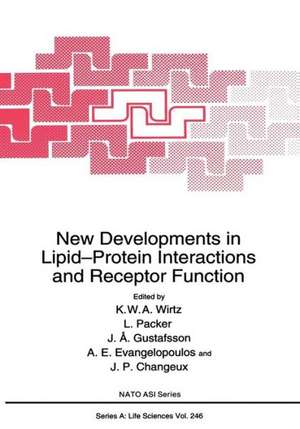New Developments in Lipid-Protein Interactions and Receptor Function: NATO Science Series A:, cartea 246
Editat de K. W. A. Wirtz, Lester Packer, J.Å. Gustafsson, A. E. Evangelopoulos, J.P. Changeuxen Limba Engleză Paperback – 24 oct 2012
Din seria NATO Science Series A:
- 15%
 Preț: 656.58 lei
Preț: 656.58 lei - 15%
 Preț: 655.13 lei
Preț: 655.13 lei - 15%
 Preț: 678.35 lei
Preț: 678.35 lei -
 Preț: 397.38 lei
Preț: 397.38 lei - 5%
 Preț: 377.87 lei
Preț: 377.87 lei -
 Preț: 397.76 lei
Preț: 397.76 lei - 18%
 Preț: 1232.41 lei
Preț: 1232.41 lei - 5%
 Preț: 731.64 lei
Preț: 731.64 lei -
 Preț: 413.15 lei
Preț: 413.15 lei - 15%
 Preț: 649.22 lei
Preț: 649.22 lei - 5%
 Preț: 369.45 lei
Preț: 369.45 lei -
 Preț: 407.56 lei
Preț: 407.56 lei - 5%
 Preț: 2162.19 lei
Preț: 2162.19 lei -
 Preț: 407.39 lei
Preț: 407.39 lei -
 Preț: 396.40 lei
Preț: 396.40 lei - 15%
 Preț: 663.93 lei
Preț: 663.93 lei -
 Preț: 387.38 lei
Preț: 387.38 lei -
 Preț: 393.13 lei
Preț: 393.13 lei -
 Preț: 398.35 lei
Preț: 398.35 lei -
 Preț: 401.24 lei
Preț: 401.24 lei - 15%
 Preț: 678.81 lei
Preț: 678.81 lei -
 Preț: 395.09 lei
Preț: 395.09 lei - 18%
 Preț: 952.40 lei
Preț: 952.40 lei - 15%
 Preț: 654.43 lei
Preț: 654.43 lei -
 Preț: 402.00 lei
Preț: 402.00 lei -
 Preț: 401.24 lei
Preț: 401.24 lei - 15%
 Preț: 655.27 lei
Preț: 655.27 lei -
 Preț: 394.71 lei
Preț: 394.71 lei -
 Preț: 384.48 lei
Preț: 384.48 lei - 5%
 Preț: 395.61 lei
Preț: 395.61 lei - 5%
 Preț: 1421.57 lei
Preț: 1421.57 lei - 15%
 Preț: 651.34 lei
Preț: 651.34 lei -
 Preț: 400.10 lei
Preț: 400.10 lei -
 Preț: 386.99 lei
Preț: 386.99 lei - 5%
 Preț: 386.11 lei
Preț: 386.11 lei -
 Preț: 403.91 lei
Preț: 403.91 lei - 15%
 Preț: 651.51 lei
Preț: 651.51 lei -
 Preț: 393.90 lei
Preț: 393.90 lei - 5%
 Preț: 376.43 lei
Preț: 376.43 lei -
 Preț: 400.26 lei
Preț: 400.26 lei - 5%
 Preț: 388.84 lei
Preț: 388.84 lei -
 Preț: 400.65 lei
Preț: 400.65 lei - 5%
 Preț: 740.58 lei
Preț: 740.58 lei - 18%
 Preț: 1225.16 lei
Preț: 1225.16 lei - 5%
 Preț: 386.46 lei
Preț: 386.46 lei -
 Preț: 421.82 lei
Preț: 421.82 lei
Preț: 394.87 lei
Nou
Puncte Express: 592
Preț estimativ în valută:
75.57€ • 78.60$ • 62.39£
75.57€ • 78.60$ • 62.39£
Carte tipărită la comandă
Livrare economică 14-28 aprilie
Preluare comenzi: 021 569.72.76
Specificații
ISBN-13: 9781461362395
ISBN-10: 1461362393
Pagini: 332
Ilustrații: IX, 318 p.
Dimensiuni: 178 x 254 x 17 mm
Greutate: 0.58 kg
Ediția:Softcover reprint of the original 1st ed. 1993
Editura: Springer Us
Colecția Springer
Seria NATO Science Series A:
Locul publicării:New York, NY, United States
ISBN-10: 1461362393
Pagini: 332
Ilustrații: IX, 318 p.
Dimensiuni: 178 x 254 x 17 mm
Greutate: 0.58 kg
Ediția:Softcover reprint of the original 1st ed. 1993
Editura: Springer Us
Colecția Springer
Seria NATO Science Series A:
Locul publicării:New York, NY, United States
Public țintă
ResearchCuprins
Components of Signal Transduction.- Intracellular Ca2+ Stores: Why, Where and How?.- The Metabolic Fates and Cellular Functions of Myoinositol.- Activation Mechanisms of Phospholipase C Isozymes.- Tumor Necrosis Factor Cytotoxicity Is Associated with Activation of Cellular Phospholipases.- Relationship between Phospholipase C, Tyrosine-Kinases and Cytoskeleton in Thrombin-Stimulated Platelets.- Lipid Modifications of GTP-Binding Regulatory Proteins.- Receptor Function and Regulation.- Lysophosphatidic Acid as a Lipid Mediator: Signal Transduction and Receptor Identification.- The Role of Lipoprotein Receptors in the Growth of Chicken Oocytes.- Modulation of Opioid Receptor Function by Membrane Lipids.- A Pharmacological Approach to Identify Hormone Signaling Pathways Controlling Gene Regulation in Dictyostelium.- Glycosyl-Phosphatidylinositol: Role in Neurotrophic Factors Signalling.- Pharmacological, Electrophysiological and Molecular Analysis of a Dopamine Receptor in a Specific Subset of Neurons in the Central Nervous System of the Pond Snail Lymnaea stagnalis.- Transcription Factors and Gene Regulation.- Regulation of Gene Expression in Rodent Hepatocytes.- Transcription Factor CREM: A Key Element of the Nuclear Response to cAMP.- Three-Dimensional Structure of the Human Retinoic Acid Receptor-? DNA Binding Domain: Implications for DNA-Binding.- Molecular Genetics of Plasma Lipid Transfer Proteins.- Biosynthesis, Insertion and Function of Membrane Components.- Targeting Signals and Mechanisms of Protein Insertion into Membranes.- Recognition of Precursor Proteins by the Mitrochondrial Protein Import Apparatus.- A Short N-Terminal Domain of Mitrochondrial Creating Kinase is Involved in Octamer Formation but not in Membrane Binding.- Transmembrane Lipid Asymmetry inEukaryotes.- Phosphatidylinositol Transfer Protein and Membrane Vesicle Flow.- Modification of Cellular Phospholipid Composition and Consequences for Membrane Structure and function.- Phospholipid Headgroups as Sensors of Electric Charge.- Membrane Phospholipids Act as DNA/RNA Receptors during Formation of Specific DNA-Nuclear Membrane Contacts and Gene Expression. A Hypothesis Based on the Study of Interaction between Phospholipid Vesicles and DNA or Polynucleotides.- Mode of Phospholipid Binding to the Membrane Active Plant Toxin Phoratoxin-A.- Biosynthesis of Glycosyl-Phosphatidylinositol Protein Anchors in African Trypanosomes.- Membrane Peroxidation and Protection.- The Effects of Oxygen-Derived Free Radicals on Lipids, Protein and their Interactions: Pathological Implications.- The Vitamin E Antioxidant Cycle in Health and Disease.- Contributors.













